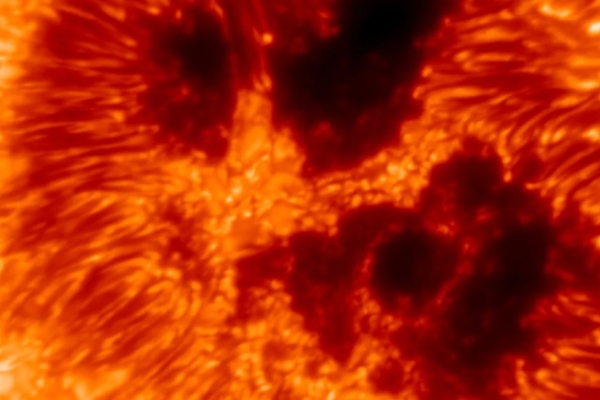The National Science Foundation’s (NSF) Daniel K. Inouye Solar Telescope has released the first image captured by the new instrument, the Visible Tunable Filter (VTF). This groundbreaking photograph shows a cluster of sunspots, with a size comparable to the entire mainland United States, if not larger.
The Daniel K. Inouye Solar Telescope is the largest solar telescope in the world. This close-up image taken in December last year reveals a group of massive sunspots in the central region of the solar inner atmosphere, with a resolution of 10 kilometers per pixel. These sunspots are high magnetic active regions, often the source of solar flares and coronal mass ejections (CMEs). The latter are plasma and magnetic field clouds ejected from the outer layer of the sun, which may disrupt the Earth’s power grid and satellite communication systems.
The image was captured using three synchronized cameras, taking hundreds of solar photos at different wavelengths through the VTF in a matter of seconds, and then synthesizing a three-dimensional image.
Developed by the Kiepenheuer Institute for Solar Physics (KIS) in Germany, VTF is the world’s largest imaging spectro-polarimeter. Its core consists of a set of dual glass plates (etalon) with precise micron-level spacing, capable of precisely filtering specific colors of light waves like a radio tuner, thereby analyzing the temperature, pressure, velocity, and magnetic field structures of different layers of the sun.
Stacey Sueoka, Senior Optical Engineer at the National Solar Observatory (NSO) in the United States, expressed, “The moment I saw the first batch of spectral scans, it was truly unbelievable. This is an achievement that other instruments in telescopes cannot reach, marking a milestone of many years of development and cross-continent team collaboration.”
The research team expects VTF to be fully operational by 2026, significantly enhancing the accuracy of solar activity observation and space weather prediction.
The sun undergoes a cycle of high and low magnetic field activity every 11 years. In October last year, the National Oceanic and Atmospheric Administration (NOAA), NASA, and the International Solar Cycle Prediction Team announced that the sun had entered the peak period of activity, called the “solar maximum.” During this period, the number of sunspots significantly increases, and the solar magnetic poles flip.
Carrie Black, Program Director of the National Solar Observatory at the NSF, emphasized, “This technological breakthrough puts the United States at the forefront of high-resolution solar observation, crucial for improving solar storm predictions.” She stated that solar storms could cause disruptions to global communication, energy, and navigation systems, making such instruments critical to strengthening early warning systems.
In addition to the Daniel K. Inouye Solar Telescope, there are currently joint missions such as the Solar Orbiter by the European Space Agency and NASA, as well as NASA’s Parker Solar Probe, the first spacecraft to touch the sun, all dedicated to unraveling the mysteries of the sun and its storm patterns.
(This article references reports from CNN and Petapixel)

